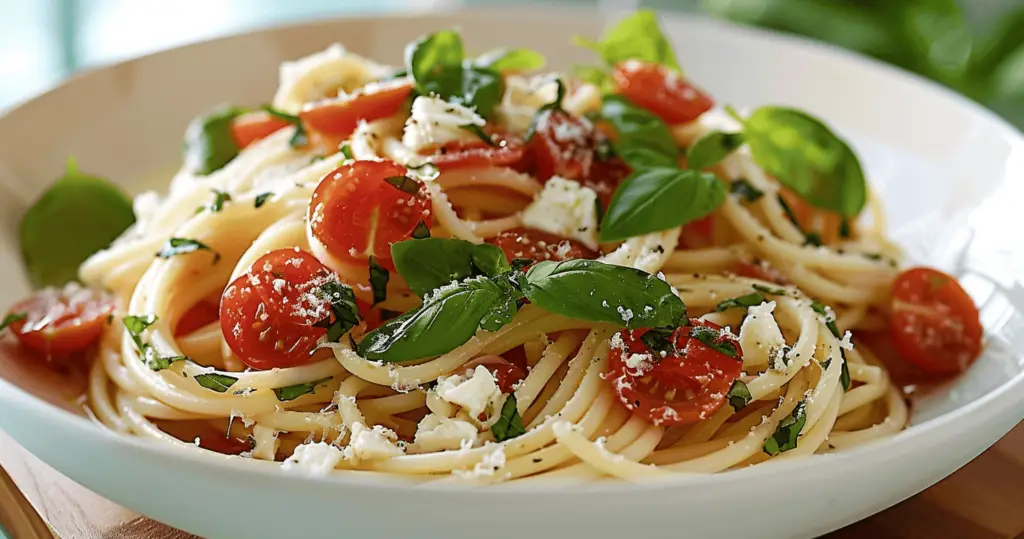Spaghetti with feta is a delightful combination that brings a Mediterranean twist to a classic Italian dish. The rich, tangy flavor of feta cheese pairs perfectly with the simplicity of spaghetti, creating a quick and flavorful meal that can be enjoyed any time. This guide will walk you through the steps to make the perfect spaghetti with feta, along with variations to suit different tastes and preferences.

Overview of Spaghetti with Feta
Spaghetti with feta is a versatile and easy-to-make dish that combines cooked spaghetti with crumbled feta cheese and other flavorful ingredients. The result is a deliciously creamy and tangy pasta dish that can be customized with various vegetables, proteins, and herbs.
Why It’s a Great Choice for a Quick and Flavorful Meal
- Ease of Preparation: Simple ingredients and straightforward steps make this dish accessible for all skill levels.
- Versatility: Easily adaptable to different tastes and dietary needs.
- Flavor: The tanginess of feta cheese adds a unique and delicious twist to traditional spaghetti.
Different Variations and Additions
- Vegetables: Cherry tomatoes, spinach, olives, roasted red peppers
- Proteins: Grilled chicken, shrimp, or tofu
- Herbs and Spices: Basil, oregano, parsley, lemon zest
Brief History and Cultural Significance
Spaghetti, a staple of Italian cuisine, has been enjoyed for centuries, while feta cheese, a key ingredient in Greek cuisine, has been cherished for its unique flavor and texture. Combining these two ingredients brings together the culinary traditions of Italy and Greece, resulting in a dish that celebrates the best of both worlds.
Origin of Spaghetti and Its Evolution
- Ancient Roots: Spaghetti has origins in ancient Rome and Greece, evolving over time into the beloved pasta we know today.
- Italian Influence: Italy popularized spaghetti, incorporating it into a variety of regional dishes.
History and Uses of Feta Cheese in Mediterranean Cuisine
- Greek Origins: Feta cheese dates back to ancient Greece, made from sheep’s milk and known for its tangy flavor.
- Culinary Uses: Used in salads, pastries, and as a topping for various dishes, feta is a versatile cheese in Mediterranean cooking.
Combining Italian and Greek Culinary Traditions
- Fusion of Flavors: The combination of spaghetti and feta brings together the rich culinary histories of Italy and Greece.
- Modern Adaptations: This fusion allows for creative adaptations and new recipes that highlight the best of both cuisines.
Preparation Phase & Tools to Use
Recipe Details
- Prep Time: 10 minutes
- Cook Time: 15 minutes
- Total Time: 25 minutes
- Servings: 4
- Yield: One pot of spaghetti with feta
Essential Tools and Equipment
- Large Pot: For boiling spaghetti.
- Colander: To drain the pasta.
- Mixing Bowl: For combining spaghetti with feta and other ingredients.
- Tongs or Pasta Fork: To toss the pasta.
- Knife and Cutting Board: For chopping vegetables and herbs.
- Measuring Cups and Spoons: For accurate ingredient measurements.
Importance of Each Tool
Each tool is essential for making the preparation process smooth and ensuring the dish turns out perfectly. The large pot is necessary for cooking the pasta, while the colander allows for easy draining. Mixing bowls and utensils ensure the ingredients are well combined.
Preparation Tips
- Use Fresh Ingredients: Fresh vegetables and herbs enhance the flavor of the dish.
- Cook Pasta Al Dente: Cooking the pasta until it is al dente provides the best texture.
- Reserve Pasta Water: Save some pasta water to adjust the sauce consistency if needed.
Ingredients List
- Spaghetti: 12 ounces
- Feta Cheese: 1 cup, crumbled
- Olive Oil: 2 tablespoons
- Garlic: 2 cloves, minced
- Cherry Tomatoes: 1 cup, halved
- Spinach: 2 cups, fresh
- Lemon Juice: 2 tablespoons
- Salt and Pepper: To taste
- Fresh Basil or Parsley: For garnish
Step-by-Step Instructions
Cook the Spaghetti
- Boil Water: Fill a large pot with water, add a generous pinch of salt, and bring to a boil.
- Cook Pasta: Add the spaghetti to the boiling water and cook according to package instructions until al dente.
- Reserve Pasta Water: Before draining, reserve 1 cup of pasta water for later use.
- Drain Pasta: Drain the spaghetti in a colander and set aside.
Prepare the Ingredients
- Chop Vegetables: While the pasta is cooking, halve the cherry tomatoes and mince the garlic.
- Heat Olive Oil: In a large mixing bowl, heat the olive oil over medium heat.
- Sauté Garlic: Add the minced garlic and sauté until fragrant, about 1 minute.
Combine Ingredients
- Add Tomatoes and Spinach: Add the halved cherry tomatoes and fresh spinach to the bowl, and cook until the tomatoes are softened and the spinach is wilted.
- Mix in Pasta: Add the cooked spaghetti to the bowl and toss to combine.
- Add Feta and Lemon Juice: Sprinkle the crumbled feta cheese and drizzle the lemon juice over the pasta. Toss gently to combine.
- Adjust Consistency: If the pasta is too dry, add a small amount of the reserved pasta water until the desired consistency is reached.
Season and Serve
- Season: Season with salt and pepper to taste.
- Garnish: Garnish with fresh basil or parsley.
- Serve: Serve the spaghetti with feta warm, with extra feta and lemon wedges on the side
Recipe Variations and Add-Ins
1. Spaghetti with Feta and Cherry Tomatoes
Preparation and Serving Suggestions:
- Ingredients: 1 cup cherry tomatoes, halved
- Instructions:
- Follow the basic recipe, adding the halved cherry tomatoes when sautéing the garlic.
- Continue with the recipe as directed.
- Serve with extra cherry tomatoes and a sprinkle of fresh basil.
2. Spaghetti with Feta and Spinach
Preparation and Serving Suggestions:
- Ingredients: 2 cups fresh spinach, roughly chopped
- Instructions:
- Follow the basic recipe, adding the spinach after sautéing the garlic.
- Cook until the spinach is wilted.
- Continue with the recipe as directed.
- Serve with a garnish of extra spinach leaves.
3. Spaghetti with Feta and Olives
Preparation and Serving Suggestions:
- Ingredients: 1/2 cup Kalamata olives, pitted and halved
- Instructions:
- Follow the basic recipe, adding the halved olives when combining the spaghetti and feta.
- Continue with the recipe as directed.
- Serve with additional olives and a sprinkle of fresh parsley.
4. Spaghetti with Feta and Lemon
Preparation and Serving Suggestions:
- Ingredients: Zest of 1 lemon, juice of 1 lemon
- Instructions:
- Follow the basic recipe, adding the lemon zest and juice when mixing in the feta.
- Continue with the recipe as directed.
- Serve with lemon wedges and a sprinkle of fresh basil.
5. Spaghetti with Feta and Roasted Red Peppers
Preparation and Serving Suggestions:
- Ingredients: 1 cup roasted red peppers, sliced
- Instructions:
- Follow the basic recipe, adding the sliced roasted red peppers when combining the spaghetti and feta.
- Continue with the recipe as directed.
- Serve with extra roasted red peppers and a sprinkle of fresh parsley.
6. Spaghetti with Feta and Pesto
Preparation and Serving Suggestions:
- Ingredients: 1/4 cup pesto sauce
- Instructions:
- Follow the basic recipe, mixing the pesto sauce into the cooked spaghetti before adding the feta.
- Continue with the recipe as directed.
- Serve with a drizzle of extra pesto and a garnish of fresh basil.
7. Spaghetti with Feta and Grilled Chicken
Preparation and Serving Suggestions:
- Ingredients: 2 grilled chicken breasts, sliced
- Instructions:
- Follow the basic recipe, adding the sliced grilled chicken when combining the spaghetti and feta.
- Continue with the recipe as directed.
- Serve with extra chicken slices and a sprinkle of fresh parsley.
8. Spaghetti with Feta and Shrimp
Preparation and Serving Suggestions:
- Ingredients: 1 pound shrimp, peeled and deveined
- Instructions:
- Sauté the shrimp in olive oil with garlic until pink and cooked through.
- Follow the basic recipe, adding the cooked shrimp when combining the spaghetti and feta.
- Continue with the recipe as directed.
- Serve with extra shrimp and a garnish of fresh basil.
Nutritional Information & Health Benefits
Nutritional Breakdown
- Calories: Approximately 400
- Fat: 18g
- Carbohydrates: 45g
- Protein: 14g
- Fiber: 3g
- Sodium: 500mg
Health Benefits of Using Fresh Ingredients and Feta Cheese
- Feta Cheese: Rich in protein and calcium, feta also contains beneficial probiotics.
- Olive Oil: High in monounsaturated fats and antioxidants, olive oil supports heart health.
- Garlic: Known for its anti-inflammatory and immune-boosting properties.
- Vegetables: Fresh vegetables like spinach and tomatoes add vitamins, minerals, and fiber to the dish.
- Lemon Juice: Adds vitamin C and enhances the absorption of iron from plant-based foods.
Common Mistakes to Avoid & How to Perfect the Recipe
Common Mistakes
- Overcooking the Pasta: Overcooked pasta becomes mushy. Cook it until al dente for the best texture.
- Using Low-Quality Feta: Low-quality feta can be too salty or lack the creamy texture. Use authentic Greek feta for the best flavor.
- Skipping the Pasta Water: Reserved pasta water helps to bind the sauce and coat the pasta evenly.
- Overloading with Ingredients: Too many add-ins can overwhelm the dish. Stick to a few complementary flavors.
Tips for Achieving the Best Results
- Use Fresh Ingredients: Fresh vegetables, herbs, and high-quality feta cheese make a significant difference in flavor.
- Balance Flavors: Taste and adjust seasoning as you go. Feta is salty, so you may need less additional salt.
- Customize to Taste: Feel free to mix and match variations and add-ins to create your perfect dish.
- Garnish for Presentation: Fresh herbs and a sprinkle of extra feta add a finishing touch and enhance the visual appeal.
Tips, Notes, Storing, and Reheating
Additional Cooking Tips
- Use High-Quality Ingredients: Opt for high-quality feta cheese and fresh vegetables to enhance the dish’s flavor.
- Al Dente Pasta: Cook the spaghetti al dente to maintain a firm texture that pairs well with the creamy feta.
- Reserve Pasta Water: Reserve some pasta water before draining to help adjust the sauce’s consistency.
Notes on Variations and Tweaks
- Herbs and Spices: Add fresh herbs like basil, oregano, or parsley for a burst of flavor. You can also incorporate spices like red pepper flakes for a bit of heat.
- Creaminess: For a creamier texture, add a splash of heavy cream or a dollop of Greek yogurt.
- Nutritional Boost: Incorporate extra vegetables like bell peppers, zucchini, or artichoke hearts for added nutrition.
Best Practices for Storing and Using Leftovers
- Refrigeration: Store leftovers in an airtight container in the refrigerator for up to 3 days.
- Freezing: For longer storage, freeze the pasta in individual portions for up to 2 months. Thaw overnight in the refrigerator before reheating.
- Reheating: Reheat leftovers in a skillet over medium heat, adding a splash of olive oil or pasta water to maintain moisture. Alternatively, microwave until heated through.
FAQs
Can I use whole wheat or gluten-free pasta?
Yes, you can use whole wheat or gluten-free pasta to suit your dietary preferences. Follow the package instructions for cooking times, as they may differ from regular pasta.
How do I prevent the feta from becoming too dry?
To prevent feta from becoming too dry, add it towards the end of the cooking process, just before serving. Mixing it with a bit of pasta water can also help maintain its creamy texture.
Can I make this dish ahead of time?
Yes, you can prepare the dish ahead of time. Store it in the refrigerator and reheat as needed. Adding a splash of olive oil or pasta water during reheating can help restore its original consistency.
What is the best way to store leftovers?
Store leftovers in an airtight container in the refrigerator for up to 3 days. For longer storage, freeze in individual portions for up to 2 months.
Can I substitute feta with another cheese?
Yes, you can substitute feta with other cheeses like goat cheese, ricotta, or Parmesan. Each cheese will impart a different flavor and texture, so choose one that complements the dish’s other ingredients.
Conclusion
Spaghetti with feta offers a delicious and convenient way to enjoy a Mediterranean-inspired meal. Its versatility allows for endless customization, making it a perfect choice for any occasion. Whether you stick to the basic recipe or try one of the variations, this dish is sure to become a favorite. Enjoy the creamy, tangy flavors and share your creations with family and friends.
For more Mediterranean recipes and culinary inspiration, explore our website and discover new ways to bring delicious, healthy meals to your table.
Print
Spaghetti with feta
Description
Learn how to make the perfect spaghetti with feta with our ultimate guide. Includes recipes, tips, variations, and FAQs
Ingredients
Ingredients List
- Spaghetti: 12 ounces
- Feta Cheese: 1 cup, crumbled
- Olive Oil: 2 tablespoons
- Garlic: 2 cloves, minced
- Cherry Tomatoes: 1 cup, halved
- Spinach: 2 cups, fresh
- Lemon Juice: 2 tablespoons
- Salt and Pepper: To taste
- Fresh Basil or Parsley: For garnish
Instructions
Step-by-Step Instructions
Step 1: Cook the Spaghetti
- Boil Water: Fill a large pot with water, add a generous pinch of salt, and bring to a boil.
- Cook Pasta: Add the spaghetti to the boiling water and cook according to package instructions until al dente.
- Reserve Pasta Water: Before draining, reserve 1 cup of pasta water for later use.
- Drain Pasta: Drain the spaghetti in a colander and set aside.
Step 2: Prepare the Ingredients
- Chop Vegetables: While the pasta is cooking, halve the cherry tomatoes and mince the garlic.
- Heat Olive Oil: In a large mixing bowl, heat the olive oil over medium heat.
- Sauté Garlic: Add the minced garlic and sauté until fragrant, about 1 minute.
Step 3: Combine Ingredients
- Add Tomatoes and Spinach: Add the halved cherry tomatoes and fresh spinach to the bowl, and cook until the tomatoes are softened and the spinach is wilted.
- Mix in Pasta: Add the cooked spaghetti to the bowl and toss to combine.
- Add Feta and Lemon Juice: Sprinkle the crumbled feta cheese and drizzle the lemon juice over the pasta. Toss gently to combine.
- Adjust Consistency: If the pasta is too dry, add a small amount of the reserved pasta water until the desired consistency is reached.
Step 4: Season and Serve
- Season: Season with salt and pepper to taste.
- Garnish: Garnish with fresh basil or parsley.
- Serve: Serve the spaghetti with feta warm, with extra feta and lemon wedges on the side.
Notes
- Use Fresh Ingredients: Fresh vegetables, herbs, and high-quality feta cheese make a significant difference in flavor.
- Balance Flavors: Taste and adjust seasoning as you go. Feta is salty, so you may need less additional salt.
- Customize to Taste: Feel free to mix and match variations and add-ins to create your perfect dish.
- Garnish for Presentation: Fresh herbs and a sprinkle of extra feta add a finishing touch and enhance the visual appeal.


Leave a Comment